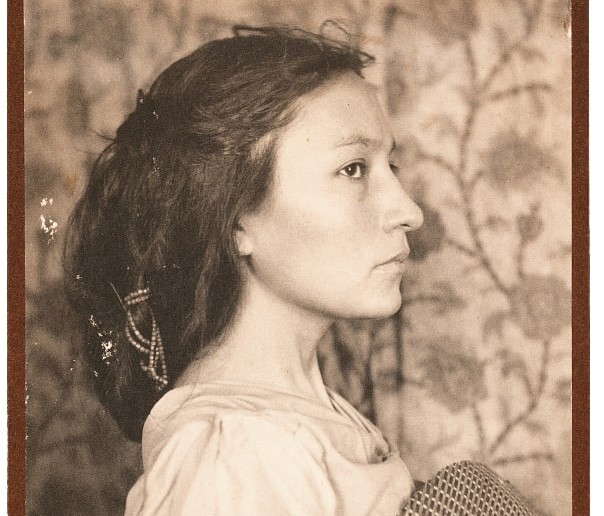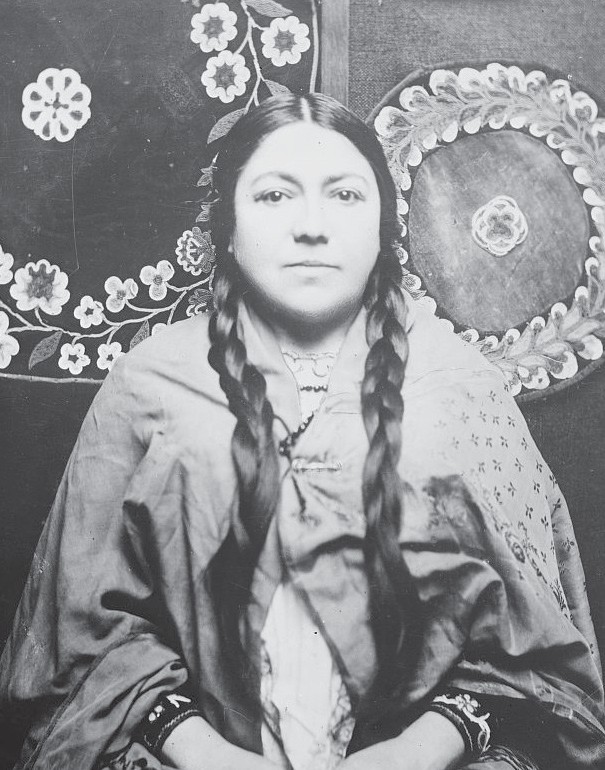Strong First Nations women tip the scales for voting rights

Gertrude Simmons Bonnin, a Suffragist and Yankton Sioux known as Zitkala-Sa. Courtesy of the Library of Congress, Illus.
First Nations women, and the empowerment they held in their egalitarian, matrilineal tribal societies, strongly influenced the Suffrage Movement in the United States. In the Northeast among the Haudenosaunee (people building the longhouse), Iroquois language speakers of the Six Nations or Iroquois Confederacy, consisting of the Oneida, Onondaga, Mohawk, Cuyuga, Seneca and Tuscarora, women held long established leadership roles as Clan Mothers. Laura Cornelius Kellogg, an Oneida woman who supported Native Rights and the rights in E99.Y25 Z57 1985. of Native Women made it clear to white Suffragettes in 1920 that they had won the rights that Native American women enjoyed for hundreds of years as tribal citizens. In the millenia-old non-hierarchical democracy of the Haudenosaunee, matriarchal influence was protected along with many culturally supported rights and responsibilities due to their time honored positions as Life Givers and the Mothers Who Raise Our Nations. Longhouses were communal, controlled by the Clans who lived in them, and land concerns were decided by Clan Mothers, who also had the duty of choosing their Clan Chiefs. They counseled him in local and treaty matters and could remove him from his office based upon acts that exposed him as self-serving and irresponsible or not promoting peace. Crimes such as murder, theft, or sexual assault were more severely punished by the Clan Mothers. There was also a clear balance of power to avert disputes between chiefs.

Marie Louise Bottineau Baldwin, a Turtle Mountain Chippewa and lifelong advocate for Native American rights.
Similar rights of women were common throughout many tribal cultures. Across Native American cultures, traditional power structures in tribal societies were designed to empower women who were responsible for everything from trinal ceremonies to deciding if or when to go to war. They had rights to property, could divorce their partner, retain parental custody and vote in tribal elections. Because of these rights already in place, many Indigenous women were less interested in U.S. citizenship and more interested in preserving traditional culture. For them citizenship meant giving up their rights to assimilate into a foreign culture where they would be dependent upon a man.
This was in sharp contrast to the patriarchal, hierarchical societies of Euro-Americans still prevalent today, evident in slogans and memes used for harassing women on social media, such as “Your body – my choice” the meme currently circulating alongside humiliating insults and name-calling, often posted by self-described “Incels” or involuntarily celebate males. This type of abusive atmosphere is extremely debilitating for women, leading to a strong sense of abandonment and unfulfillment. The backlash of this is manifested by depression, anxiety, and fear, an underlying sense of helplessness that must then be overcome.
Euro-American suffragists from the mid-1800s through the early years of the 20th century admired and were greatly influenced by First Nations women for the respect, rights, powers, and high-level duties they held within their societies.
Marie Louise Bottineau Baldwin, a Turtle Mountain Chippewa and lifelong advocate for Native American rights, was a strong voice for the rights of Native American women and became involved in the Suffrage Movement in 1911. Having marched in the 1913 suffrage parade at the age of 50, she then along with several other prominent suffragists, met with President Wilson in 1914 to enlist his support for women’s Suffrage.
The Suffragettes, as they were known, fought valiantly for decades, with several states granting women the right to vote between 1869 and 1917, Wyoming being the first. They finally succeeded at the federal level with the passage of the 19th Amendment to the US Constitution on August 18, 1920, making it unconstitutional to deny voting rights based on sex, but it failed to address the matter of race or the matter of Native American citizenship.
First Nations women, many of whom were heavily invested in the Suffrage Movement, did not give up.
Gertrude Simmons Bonnin, a Suffragist and Yankton Sioux known as Zitkala-Sa, moved to Washington D.C. in 1916 at the age of 40 to work as a Congressional lobbyist in order to secure rights for Native Americans. Zitkala-Sa Became an Editor for the Journal of the Society of American Indians, also holding the office of Secretary for the organization. Her work and sphere of influence was instrumental in the passage of the Snyder Act in Congress, also called The Indian Citizenship Act of 1924, giving Indigenous Americans full U.S. citizenship. Even so, the Snyder Act did little to allow Native Americans to participate in elections, because regarding any election, whether federal, state or local, the Constitution left decisions about who can vote up to the individual states, much like what is happening today with the abortion rights issue. The dependency on the states led to unfair address requirements and voting restrictions, currently known as gerrymandering, deliberately preventing Native Americans, especially those living on reservations, from voting
It was 41 years later during the height of the Civil Rights Movement that the 1965 Voting Rights Act was passed, addressing the rights of Native Americans to vote at the federal level. Additional federal legislation was needed in subsequent years in order to secure access to federal elections for Native Americans. By 2020, Indigenous Americans has less voting rights than in previous decades due to convoluted ID requirements, insufficient number and location of voting sites, and poor management of counting ballots. In the recent election, we have seen the same scenario playing out. Many voters are concerned that their votes are not counted and have contacted their local get-out-the-vote groups to find out for sure. We are at a pivotal moment, a crossroads, and this fight is not over!
Contact Aliyah Keuthan at kestraldancing@
The post Strong First Nations women tip the scales for voting rights first appeared on Native Sun News Today.
Tags: Top News
